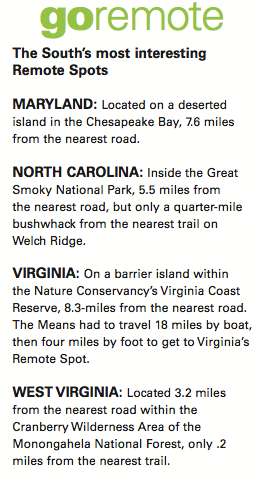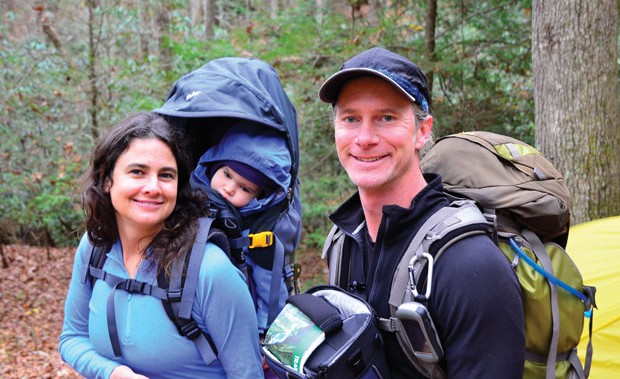Think it’s tough to avoid the crowds at your favorite backcountry destination? You have no idea. Ryan and Rebecca Means spend their free time looking for the rarest resource in America: remote spots. It’s called the Project Remote, and it has the couple (and their three-year-old daughter) hiking to the farthest point from any road in each state. The two biologists and their daughter have stood in the most remote spots in 12 states so far, and have plans to knock out the next 38 in coming years.
What made you two decide to start looking for the most remote spots in the country?
Ryan: I was hiking down a crowded beach with a backpack near St. Augustine, Florida two years ago, thinking about how difficult it is to get away from the hordes of people within Florida, which is a very densely populated state. I started wondering just how far one could be away from people and development in Florida. The Everglades instantly came to mind…then I wondered where the single most remote location in the entire state might be. Once Rebecca and I started calculating where that remote spot might be, we began thinking about the implications of how un-remote much of our country is, and how most people don’t realize the prevalence of roads in our culture. So we decided to not only Go Remote, but to document existing remoteness in our country to raise awareness and provide a baseline for future generations.
How difficult is it to get away from a road in the South today?
Ryan: It’s very difficult. But physically getting away from a road is just one problem. We discovered in Arkansas you can hear the booming roar of a US Hwy almost three miles away, all day and night while standing on the Arkansas Remote Spot.
Rebecca: It is very telling that we only had to spend the night on three of our 12 expeditions so far. For all the others, we could reach, document, and get back to our point of departure within a single day.
What’s the most remote spot below the Mason Dixon?
Rebecca: In Florida, on an island 25 miles from a road. Even if you are talking about just mainland Remote Spots, not including islands, the Florida mainland Remote Spot is still 17 miles from the nearest road. The next most remote spot is in Mississippi, eight miles from the nearest road and is on a barrier island. Of the 12 states we’ve visited from New Jersey to Florida and west to Missouri, the average distance from a road is only 5.5 miles.
 According to your criteria, what constitutes a road? Does it have to be paved?
According to your criteria, what constitutes a road? Does it have to be paved?
Rebecca: A road is a path on which vehicles are permitted to travel, paved or not. In fact, we include beaches (such as Assateague Island National Seashore) that have designated driving tracks. The gray area comes with private property. Do we count the tracks that a rancher makes through the property? No. Do we count the roads crisscrossing the landscape on mining industry lands? Yes. Public lands also give us trouble because there are roads on which staff is permitted to drive (think National Wildlife Refuges), but the public are not. But we have a set methodology to deal with these situations.
What does that excess of roads mean for us environmentally and culturally?
Ryan: The implications are alarming. The baseline of what we consider remote is shifting. Kids now are growing up without access to wildness and they don’t even realize it because this is all they’ve known. We are rapidly changing from being a country of people who appreciate and are proficient in the outdoors into a culture of people who may never get to experience wildness and reap those rewards. The list of environmental implications of all these roads is lengthy. First and foremost is habitat fragmentation. Smaller and smaller chunks of habitat are unhealthy for the proper function of ecosystems. Roads are literal barriers to movements for thousands of animal species. Can you imagine a salamander trying to cross I-75?
Are you recording certain data or simply seeking out the solitude?
Rebecca: We start by taking a 360-degree panoramic video while standing on the spot, then repeat the process with still photos. We also spend 15 minutes conducting what we call the Remote Spot Assessment – to record quantitative data on human sounds or sights. Then we take general descriptive notes about the ecology and any wildlife we see or hear. We turn on a cell phone to see if there is coverage at the Remote Spot. Often times, land management regulations do not allow us to spend the night on the Spot so we are rushed to return to camp or our boat/canoe before nightfall.
What do you hope people will take away from Project Remote?
Ryan: We hope that people will be inspired to get outdoors more. We hope people will begin to understand that roads permeate the natural landscape so fully that it is no longer possible to get much more than five miles from a road in many states. And we hope the general public becomes more knowledgeable and caring about the negative impacts of so many roads. We want the average person to feel that we should keep Roadless Areas road-less forever.
Do you have a favorite remote spot so far?
Ryan: Florida and North Carolina. Florida’s mainland Remote Spot was along a simply beautiful, pristine coastline 17 miles from the nearest road with the Everglades and the ocean sandwiching the R-spot. By the way, Florida has by far the remotest Remote Spot in the entire Lower 48 states–25 miles from the nearest road within the Marquesas Islands. The next most remote location is 21 miles in Wyoming’s Yellowstone National Park. North Carolina’s was embedded within the center of the Great Smoky Mountains National Park, five miles from a road. A very beautiful heart of the highest part of the Appalachian Chain.
Rebecca: I’m going to say Virginia. We had a long, isolated beach hike to get to the Spot and I was able to share the experience with my Dad and step-ma. I love a wild beach and this one was definitely wild.








